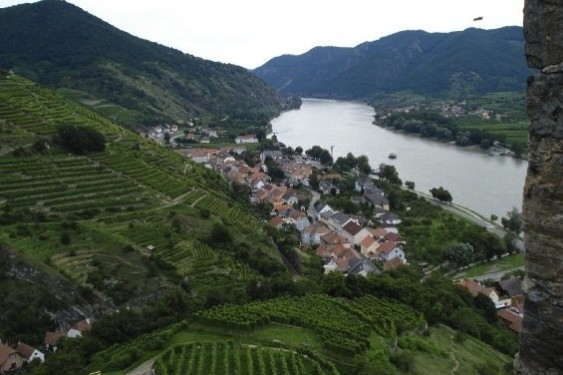Forget Hillary’s email-gate and the Ashley Madison hack. I’ve got a salacious scandal to entertain your friends with at shindigs this weekend…especially if you’re bringing along a crisp Riesling or Grüner Veltliner to enjoy in the hot summer weather.

Forget the taste – anti-freeze can be toxic in high enough quantities! Image credit: PewDiePie.
The year was 1985. Austrian wine production was up, and exports were booming. Until, that is, a grocery store in Stüttgart noticed something funny about the sweet Austrian white wines it was stocking.
Turns out that, when the store sent wine samples into a lab for analysis, the bottles had been laced with a chemical compound called diethylene glycol, or DEG for short, that was a common component of antifreeze. As in, the stuff you put in your car so it works in winter.
Unlike with automotive systems, however, DEG is toxic to humans, and in high enough concentrations, can damage the brain, kidneys and liver. The tainted wine had also been shipped to other countries, including the US. You can even read this New York Times article about it from August 1985. In fact, the Bureau of Alcohol, Tobacco and Firearms found at least 12 Austrian wine brands imported to the US contained the compound, while 350 Austrian wines in all were banned in West Germany (yes, it was still West Germany back then).
So why add the compound in the first place? Because it makes wine taste sweeter and more full-bodied. Though Austria wasn’t, and still isn’t, one of the world’s larger wine-producing countries, it does make a fair amount of the stuff. In the ’80s, several Austrian wine producers signed big contracts with supermarket chains in Germany to deliver sweet-style wines. Sweetness is one of the elements by which wines (and especially those of Germany and Austria, such as Riesling and Grüner Veltliner) are judged and priced. Generally, the sweeter the wine, the higher the price producers or merchants got for it.
However, several harvests, notably that of 1982, were especially poor. Climate change caused higher yields and less-ripe grapes. The wine made from them was thin and flavorless. The producers had to make up for it somehow or risk losing their contracts.

Many of the tainted wines came from Austria’s Danube Valley.
The solution, courtesy of an Austrian chemist named Otto Nadrasky, was to add DEG to the wine. You only needed about $5 worth of diethylene glycol for every 1,000 liters (or about 264 gallons), making it cheap and easy. DEG can be lethal in concentrations of 40 grams per liter or higher, but many of the tainted wines were found to have just a few grams, or even fractions of a gram per bottle, so you would have had to drink a lot over a long period of time to truly suffer injury.
Not only that, but several wines spiked with the stuff even won awards at European wine shows! That mystified a few critics and Austrian government officials, who began to investigate covertly. But even when they knew what had happened, they didn’t inform wine industry professionals or trading partners for about three months, making the German discovery all the more egregious.
In all, about 30 people were sentenced to jail time, with the maximum sentence being 10 years, and one convicted winemaker even committed suicide.
The effects on the Austrian wine industry were just as grim. Wine exports dropped over 90% from about 12 million gallons in 1984 to just over 1 million in 1986. The industry was literally decimated. Exports finally returned to pre-scandal levels in 2001…a full 15 years later!
However, the scandal also had some very positive unintended consequences (eventually) as well. Instead of buying nondescript wines in stores and supermarkets, consumers in Austria and wine professionals began going right to the source – the winemakers. They began purchasing wines made by people they trusted in totally clean, honest ways. Not only that, but the destruction of several large firms and cooperatives meant that there was room for a cadre of young winemakers untouched by the scandal to flourish and help reinvigorate the country’s wine industry.
Today, the high quality of Austrian wines is indisputable. Folks there will still talk about the scandal, but in a way that shows they are proud how far their wine has come since then. So next time you see an Austrian wine on a shelf or a list (and hey, check your local store for some this weekend), you’ll appreciate the quality and clarity of flavor, style and sensibility all the more.
Here are a couple fantastic Austrian producers whose wines are generally available in the US. If you come across them, I’d suggest giving them a try…and then tweet me @clustercrush to tell me how you like them!

Today, Austria makes phenomenal wines, including this lineup from Geyerhof. Photo courtesy of Geyerhof.
F.X. Pichler: With a dramatic new facility in Austria’s picturesque Wachau region (on the Danube), this family-owned winery (fifth-generation son Lucas Pichler is the current winemaker) makes some of the country’s best single-vineyard Grüner Veltliners and Rieslings.
Nikolaihof: One of the pioneers of biodynamic winemaking in Austria, with a phenomenal range of white wines at various price points.
Geyerhof: Winemaker Ilse Maier’s family has been in the hilltop village of Oberfucha for over 400 years, but she has made a name for herself by producing some of Austria’s finest white wines according to strict organic and sustainable guidelines.
Hirsch: Venture a little farther afield from the Wachau up into the nearby Kamptal area to try racy white wines produced biodynamically from some of the region’s most interesting sites.
Moric: The wild card on my list. Moric is a producer (Roland Velich is the winemaker) in the Burgenland region south of Vienna and is known for Blaüfrankirsch, one of Austria’s flagship red wine varieties. Try them and see what you think!

